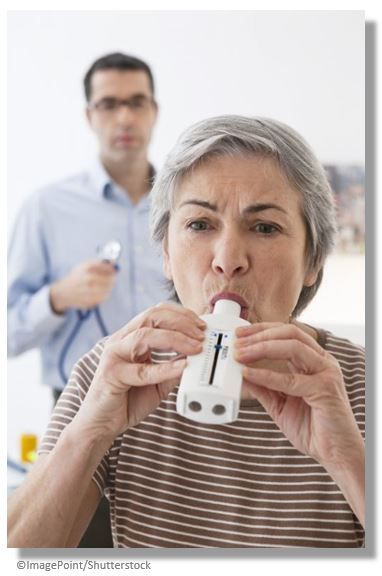- Clinical Technology
- Adult Immunization
- Hepatology
- Pediatric Immunization
- Screening
- Psychiatry
- Allergy
- Women's Health
- Cardiology
- Pediatrics
- Dermatology
- Endocrinology
- Pain Management
- Gastroenterology
- Infectious Disease
- Obesity Medicine
- Rheumatology
- Nephrology
- Neurology
- Pulmonology
Simple 5-question Screening Tool Could Improve COPD Diagnosis in Primary Care

An investigational 5-question screening tool identified approximately one half of a cohort of primary care patients aged 45-80 years with chronic obstructive pulmonary disorder (COPD) that could benefit from available treatments, according to study findings published February 14 in JAMA.
While this initial performance was promising, investigators say, results of the nationwide study indicate that further research is needed to optimize the tool and to understand whether its use affects clinical outcomes.
The consortium of investigators from Weill Cornell Medicine, New York-Presbyterian, the University of Michigan, Ann Arbor, National Jewish Health, and the University of Minnesota say the results also underscore the challenge of identifying undiagnosed patients with COPD in primary care.
“Unfortunately, many patients with COPD go undiagnosed and are often not picked up until their disease is quite advanced. As treatments for COPD improve, we have increasing ability to prevent morbidity and mortality among COPD patients,” said MeiLan King Han, MD, MS, co-principal investigator on this study and chief of the Division of Pulmonary and Critical Care at the University of Michigan, in a statement. “That’s why studies such as CAPTURE are so important to identify patients in primary care who would benefit from treatment.”
The COPD Assessment in Primary Care To Identify Undiagnosed Respiratory Disease and Exacerbation Risk) COPD screening tool, known as CAPTURE, uses 5 symptom and exposure questions and, for a subset of patients, peak expiratory flow rates (PEFR), to detect patients with undiagnosed COPD who are candidates for immediate therapy, labeled as having clinically significant COPD), study authors explain. The screening generates a score that determines if a patient should undergo additional testing and clinical evaluation.
“Unfortunately, many patients with COPD go undiagnosed and are often not picked up until their disease is quite advanced. As treatments for COPD improve, we have increasing ability to prevent morbidity and mortality among COPD patients.”
Questions from CAPTURE have been evaluated previously in global, cross-sectional analyses of specific populations but with limited use of the PEFR component. The research team designed the current study to validate the predictive accuracy of the full tool in identifying patients with previously undiagnosed, clinically significant COPD in a diverse US primary care population.
Investigators enrolled patients who completed a single study visit at 7 experienced primary care practice–based research networks between October 12, 2018, and April 1, 2022. Participating practices varied in size, rural vs urban location, and patient characteristics (race and ethnicity and socioeconomic status). Data collected at the primary care visit comprised CAPTURE questionnaire responses, PEFR, COPD Assessment Test (CAT) scores, history of acute respiratory illnesses, demographics, and spirometry results.
The investigators identified the primary study outcome as the CAPTURE tool’s sensitivity and specificity for identifying patients with undiagnosed COPD. The secondary outcomes of interest included analyses of varying thresholds for defining a positive screening result for clinically significant COPD.
FINDINGS
The final cohort of participants with adequate data for analysis numbered 4325 of which 63% were women; mean age was 61.6 years. The team reports that of the 4325 patients, 333 (7.7%) had spirometry-defined COPD (110 [2.5%] clinically significant COPD, 223 [5.2%] COPD that was not clinically significant).
Of the 110 patients (2.5%) with undiagnosed, clinically significant COPD, 53 had a positive screening result with a sensitivity of 48.2% (95% CI, 38.6%-57.9%) and a specificity of 88.6% (95% CI, 87.6%-89.6%). CAPTURE provided false positives for 479 participants (11%) who did not have COPD.
“The study shows that there is a high degree of respiratory burden in primary care, and physicians need to ask about it and do the appropriate testing to determine if symptoms are driven by COPD or another process so that patients can get the right treatment,” said University of Michigan’s Han.
“The study shows that there is a high degree of respiratory burden in primary care, and physicians need to ask about it and do the appropriate testing to determine if symptoms are driven by COPD or another process so that patients can get the right treatment.”
The authors concur that while CAPTURE requires additional evaluation, “the tool shows early effectiveness for detecting people who have more severe cases of obstructed airflow, asthma, and a history of respiratory illness,” said James P. Kiley, PhD, director of National Heart, Lung, and Blood Institute’s Division of Lung Diseases, in a NHLBI statement. “By conducting additional testing for these patients, primary care physicians can get closer to providing more adults with undiagnosed COPD with appropriate treatment and care.”
Larger studies are underway to assess CAPTURE and how physicians use the tool in practice, according to the NHLBI. Results are expected to be available later this year.
The research was partially funded by NHLBI through grant 1R01HL136682.
Reference: Martinez FJ, Han MK, Lopez C, et al. Discriminate accuracy of the CAPTURE tool for identifying chronic obstructive pulmonary disease in US primary care settings. JAMA. Published online February 14, 2023. doi: 10.1001/jama.2023.0128.
